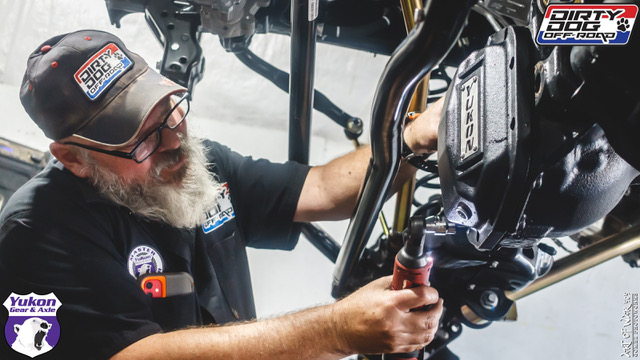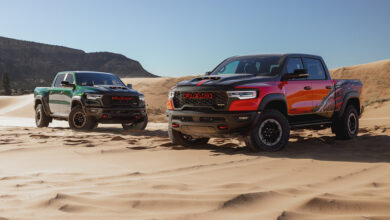Q&A: Developing Employee Training Programs with Dirty Dog Off-Road

Editor’s Note: This interview has been lightly edited for length and clarity.
THE SHOP contributor Arun Coumar of Driven Performance Advisors caught up with Fred Hawkins of Dirty Dog Off-Road, located in Albuquerque, New Mexico, to learn about his shop’s role in creating Yukon Gear & Axle’s Certified Driveline Installer program.
Hawkins, the owner of Dirty Dog Off-Road, began working on cars as a kid, building dragsters and off-road trucks with his family. He began his professional career with a car alarm manufacturer, serving as its National Training Manager before retiring to begin his second career as a firefighter and Jeep-building hobbyist. By 2014, the Jeep building had become nearly a full-time job, and Hawkins opened New Mexico Jeep Builders, the predecessor to Dirty Dog Off-Road. Fred’s team grew from just himself in an 800-sq.ft. shop to 4 employees in a 3,000-sq.ft. shop, crafting capable off-road vehicles.
Q: Fred, tell me a bit about Yukon’s certified installer program.
Fred Hawkins: Yukon Gear and Axle has had a master installer program for a number of years. In fact, I am a master installer. The certified installer program serves as a bridge for new technicians to grow into proficiency in gear installing, which provides all sorts of benefits to the shop, Yukon and the tech.
The certified installer program combines book learning and hands-on learning for new techs to help them reach a high level of proficiency for installing Yukon gear and axle products. The book learning aspect is self-taught and gives the technician much of the baseline knowledge required to properly install gears. The practical learning is, obviously, where we get to see the rubber meet the road.
Under supervision from a Yukon master installer, the trainee must complete a Gear Installer Task Book, which is a documentation of 30 gear installs, fulfilling several different criteria, taking photos and taking logs of changes made. For each job, the technician will complete a gear sheet, similar to the printout you get after doing an alignment, that shows the before and after for the measurable components of their gear sets.
After the 30 gear sheets are completed, which in our shop takes about 14 to 15 months, the task book is reviewed and then sent off to Yukon to become certified.
Q: How have you been involved in developing the program?
FH: I developed the gear sheet task book for Yukon, having borrowed the idea from my fire department days. Most of the written learning had already been developed by Yukon, so it was mostly a matter of building a set of criteria and parameters that must be documented for each install to ensure that the technician is taking in all of the most critical aspects of a gear install while they learn.
Q: How did that opportunity arise?
FH: I am a huge customer of Yukon. In getting to know them and talking with the team over time, it became clear that while they had a strong master installer program that benefitted shops and Yukon, there was no bridge to get new technicians from beginner to the master level. We set out to create that bridge, and when the program is officially released in the near future, we will have succeeded.
Q: Has it been worthwhile?
FH: Absolutely. Let me tell you a story.
We had a customer come in for some gears on their Jeep. We had one of our installers in the program perform the install and rigorously documented the whole process for his own training purposes. After we completed our work, the customer took the Jeep to get dealer warranty work done in the rear end.
Soon after the customer picked up her Jeep from the dealer, she noticed a whining noise coming from her rear diff. She took the vehicle back to the dealer. Their inspection revealed that the freshly installed gears had been completely chewed up. The dealer pointed the finger at us for a faulty install. We didn’t even let the customer leave the dealer. We pulled out the gear sheet and sent all our photos and specs to the dealer, verifying a proper install. The dealer then looked into the issue further and found that they had installed the carrier assembly backwards.
The customer received a completely rebuilt rear end, courtesy of the dealer. Without our documentation, which served the dual purpose of training and protection, we would have been in for a nasty fight.
In addition, I’ve found that our new technician recruiting and retention has improved. Since we started developing the program around 18 months ago, we have not lost a single tech. Given the program itself takes a little over a year to complete, and the training is tied to a master installer to certify the gear sheets that go into the task book, a technician is required to stay at one shop in order to achieve the certification. Also, offering a tangible, career-boosting training program to our new hires is a great way to get them in the door in the first place.
Q: Could you explain how other shops could get involved doing similar work with their manufacturers?
FH: For other shops looking to take on similar co-development opportunities, there is now a framework in place. First, you [have] to identify the skill gap in your current work. As a shop owner, you may find yourself significantly ahead in skills from your staff in certain areas, just due to years of experience on the job. The key is to find a teachable skill gap in which you can design the means of teaching that skill both with hands-on experience and book-style learning.
I’d recommend designing the framework for your curriculum first before approaching a manufacturer. When you go to your counterpart with the framework, you can say, “hey look, I think this could be useful for our industry. Would you like to put your name on it and help me develop the nuts and bolts to make it work?” Then you can work with your suppliers to create a task book full of your gear sheet equivalent, which you can use to assess your technicians in training on whatever specific skill they are learning.
Q: Would you do it again with a different manufacturer?
FH: 100%. Some of our customers value our certifications and we value certifications for the sake of all our customers. Not only does the documentation save us time after time, but given what its done for our recruiting and retention, it is increasing the professionalism for the whole industry. When we get customers asking for certified installers, it makes the whole market better. The better we make our market, the better it is for everyone.



